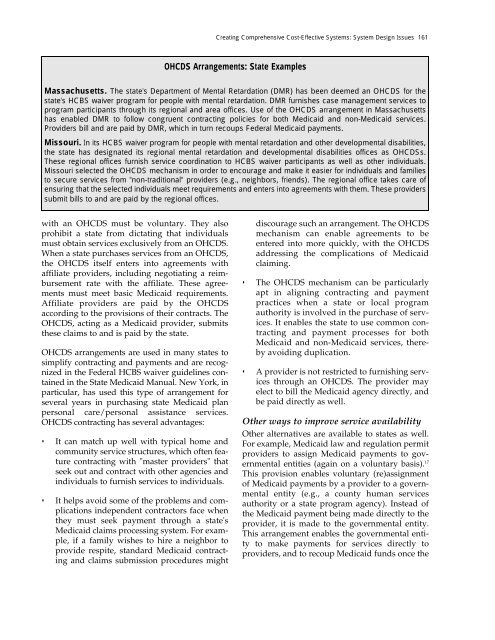Full PDF Version - ASPE - U.S. Department of Health and Human ...
Full PDF Version - ASPE - U.S. Department of Health and Human ...
Full PDF Version - ASPE - U.S. Department of Health and Human ...
- No tags were found...
Create successful ePaper yourself
Turn your PDF publications into a flip-book with our unique Google optimized e-Paper software.
Creating Comprehensive Cost-Effective Systems: System Design Issues 161OHCDS Arrangements: State ExamplesMassachusetts. The state's <strong>Department</strong> <strong>of</strong> Mental Retardation (DMR) has been deemed an OHCDS for thestate's HCBS waiver program for people with mental retardation. DMR furnishes case management services toprogram participants through its regional <strong>and</strong> area <strong>of</strong>fices. Use <strong>of</strong> the OHCDS arrangement in Massachusettshas enabled DMR to follow congruent contracting policies for both Medicaid <strong>and</strong> non-Medicaid services.Providers bill <strong>and</strong> are paid by DMR, which in turn recoups Federal Medicaid payments.Missouri. In its HCBS waiver program for people with mental retardation <strong>and</strong> other developmental disabilities,the state has designated its regional mental retardation <strong>and</strong> developmental disabilities <strong>of</strong>fices as OHCDSs.These regional <strong>of</strong>fices furnish service coordination to HCBS waiver participants as well as other individuals.Missouri selected the OHCDS mechanism in order to encourage <strong>and</strong> make it easier for individuals <strong>and</strong> familiesto secure services from "non-traditional" providers (e.g., neighbors, friends). The regional <strong>of</strong>fice takes care <strong>of</strong>ensuring that the selected individuals meet requirements <strong>and</strong> enters into agreements with them. These providerssubmit bills to <strong>and</strong> are paid by the regional <strong>of</strong>fices.with an OHCDS must be voluntary. They alsoprohibit a state from dictating that individualsmust obtain services exclusively from an OHCDS.When a state purchases services from an OHCDS,the OHCDS itself enters into agreements withaffiliate providers, including negotiating a reimbursementrate with the affiliate. These agreementsmust meet basic Medicaid requirements.Affiliate providers are paid by the OHCDSaccording to the provisions <strong>of</strong> their contracts. TheOHCDS, acting as a Medicaid provider, submitsthese claims to <strong>and</strong> is paid by the state.OHCDS arrangements are used in many states tosimplify contracting <strong>and</strong> payments <strong>and</strong> are recognizedin the Federal HCBS waiver guidelines containedin the State Medicaid Manual. New York, inparticular, has used this type <strong>of</strong> arrangement forseveral years in purchasing state Medicaid planpersonal care/personal assistance services.OHCDS contracting has several advantages:• It can match up well with typical home <strong>and</strong>community service structures, which <strong>of</strong>ten featurecontracting with "master providers" thatseek out <strong>and</strong> contract with other agencies <strong>and</strong>individuals to furnish services to individuals.• It helps avoid some <strong>of</strong> the problems <strong>and</strong> complicationsindependent contractors face whenthey must seek payment through a state'sMedicaid claims processing system. For example,if a family wishes to hire a neighbor toprovide respite, st<strong>and</strong>ard Medicaid contracting<strong>and</strong> claims submission procedures mightdiscourage such an arrangement. The OHCDSmechanism can enable agreements to beentered into more quickly, with the OHCDSaddressing the complications <strong>of</strong> Medicaidclaiming.• The OHCDS mechanism can be particularlyapt in aligning contracting <strong>and</strong> paymentpractices when a state or local programauthority is involved in the purchase <strong>of</strong> services.It enables the state to use common contracting<strong>and</strong> payment processes for bothMedicaid <strong>and</strong> non-Medicaid services, therebyavoiding duplication.• A provider is not restricted to furnishing servicesthrough an OHCDS. The provider mayelect to bill the Medicaid agency directly, <strong>and</strong>be paid directly as well.Other ways to improve service availabilityOther alternatives are available to states as well.For example, Medicaid law <strong>and</strong> regulation permitproviders to assign Medicaid payments to governmentalentities (again on a voluntary basis). 17This provision enables voluntary (re)assignment<strong>of</strong> Medicaid payments by a provider to a governmentalentity (e.g., a county human servicesauthority or a state program agency). Instead <strong>of</strong>the Medicaid payment being made directly to theprovider, it is made to the governmental entity.This arrangement enables the governmental entityto make payments for services directly toproviders, <strong>and</strong> to recoup Medicaid funds once the
















